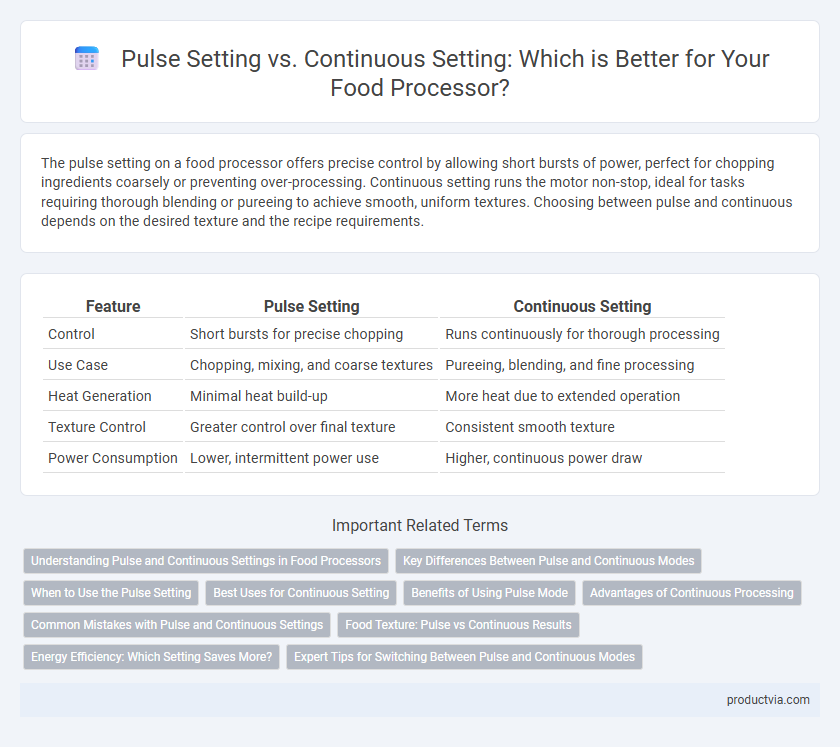The pulse setting on a food processor offers precise control by allowing short bursts of power, perfect for chopping ingredients coarsely or preventing over-processing. Continuous setting runs the motor non-stop, ideal for tasks requiring thorough blending or pureeing to achieve smooth, uniform textures. Choosing between pulse and continuous depends on the desired texture and the recipe requirements.
Table of Comparison
| Feature | Pulse Setting | Continuous Setting |
|---|---|---|
| Control | Short bursts for precise chopping | Runs continuously for thorough processing |
| Use Case | Chopping, mixing, and coarse textures | Pureeing, blending, and fine processing |
| Heat Generation | Minimal heat build-up | More heat due to extended operation |
| Texture Control | Greater control over final texture | Consistent smooth texture |
| Power Consumption | Lower, intermittent power use | Higher, continuous power draw |
Understanding Pulse and Continuous Settings in Food Processors
The pulse setting in food processors delivers short bursts of power, allowing precise control over chopping and mixing textures, ideal for tasks like coarse chopping or mixing delicate ingredients. The continuous setting operates the appliance at a steady speed, suited for thorough blending, pureeing, or kneading dough with consistent results. Understanding when to use pulse versus continuous enhances cooking efficiency and prevents over-processing of ingredients.
Key Differences Between Pulse and Continuous Modes
The Pulse setting on a food processor operates in short bursts, allowing precise control over the texture by preventing over-processing, ideal for chopping or coarse mixing. Continuous setting runs the blades nonstop, suitable for tasks requiring thorough blending or pureeing of ingredients. Key differences include control level, processing speed, and end texture consistency, with Pulse offering precision and Continuous providing uniform results.
When to Use the Pulse Setting
The Pulse setting on a food processor provides short bursts of power, ideal for controlling the texture of ingredients when chopping nuts, vegetables, or making salsa without overprocessing. Use the Pulse setting to achieve coarse or chunky results, as it allows manual control over the chopping duration and prevents ingredients from turning into puree. This setting is especially useful for recipes requiring precise texture and consistency, such as pesto, chunky dips, or dough preparation.
Best Uses for Continuous Setting
The Continuous setting on a food processor is ideal for tasks requiring consistent and thorough blending, such as pureeing soups, making dough, or shredding vegetables. This setting maintains a steady motor speed, ensuring even texture and efficient processing of large quantities. Continuous operation also supports extended blending times needed for complex recipes without manual intervention.
Benefits of Using Pulse Mode
Pulse mode in a food processor provides precise control over chopping, allowing users to achieve desired textures without over-processing ingredients. This setting helps maintain the integrity of delicate foods like nuts and herbs by preventing them from turning into a paste. Pulse mode also reduces the risk of overheating the motor, extending the appliance's lifespan during intensive tasks.
Advantages of Continuous Processing
Continuous processing in a food processor enables consistent, uniform chopping and mixing, ideal for recipes requiring smooth textures such as purees and doughs. This setting offers efficient handling of larger quantities by maintaining steady power and blade rotation, reducing preparation time. It also ensures better control over processing intensity, preventing unevenly processed ingredients common with pulse mode.
Common Mistakes with Pulse and Continuous Settings
Using the pulse setting improperly often results in uneven chopping or over-processed ingredients due to short, inconsistent bursts. Continuous setting mistakes include running the motor too long, which can cause overheating or turning ingredients into unwanted purees. Optimal use of each setting requires recognizing their distinct functions: pulse for controlled chopping and continuous for thorough mixing or blending.
Food Texture: Pulse vs Continuous Results
The pulse setting in a food processor delivers short bursts of power, allowing precise control over food texture, ideal for coarser or chunkier results. Continuous setting runs the blades nonstop, producing smoother and more uniform textures, perfect for purees or batter. Choosing between pulse and continuous settings directly impacts the consistency and quality of the processed ingredients.
Energy Efficiency: Which Setting Saves More?
The Pulse setting on a food processor uses short bursts of power, making it more energy-efficient for tasks requiring precision and control, as it prevents over-processing and reduces unnecessary motor run time. Continuous setting keeps the motor running steadily, ideal for blending large quantities but consumes more energy due to prolonged operation. Choosing the Pulse setting for smaller or intermittent processing jobs maximizes energy savings by minimizing power use without compromising performance.
Expert Tips for Switching Between Pulse and Continuous Modes
Experts recommend using the pulse setting on a food processor for precise control when chopping or mixing delicate ingredients, preventing over-processing. Continuous mode suits tasks requiring thorough blending or pureeing, ensuring even texture across larger batches. Switching between modes strategically can enhance texture outcomes and reduce ingredient damage for optimized food preparation.
Pulse setting vs Continuous setting for food processor Infographic

 productvia.com
productvia.com